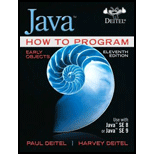
Java How to Program, Early Objects (11th Global Edition) - Does NOT include MyLab Programming
11th Edition
ISBN: 9780134800301
Author: Harvey Deitel, Paul J. Deitel
Publisher: Pearson Global Edition
expand_more
expand_more
format_list_bulleted
Expert Solution & Answer
Chapter 3, Problem 2.5SRE
Program Description Answer
The variables declared in the body of a particular method are called as local variables and can be used only in the method in which they are declared.
Hence, the given statement is “False”.
Expert Solution & Answer
Want to see the full answer?
Check out a sample textbook solution
Students have asked these similar questions
Create a relationship between the common field (Technician Number) of the two tables. Make sure that each client must have 1 and only 1 technician assigned, and each technician can have multiple clients.
2. Create a query to show the Client Number, Client Name, Billed, Paid for clients in Anderson city. Save the query.
3. Create a query to show the Technician Number, Last Name, First Name, YTD Earnings for technicians whose Hourly Rate is greater than or equal to 30. Save the query.
4. Create a query to show Client Number, Client Name, Billed, Paid for clients whose technician number is 22 and whose Billed is over 300. Save the query.
5. Create a query to show the Technician Number, Last Name, First Name, Client Number, Client Name for clients whose technician number 23. Save the query.
6. Create a query to show the Technician Number, Last Name, First Name, Client Number, Client Name for clients whose technician number 23 or 29. Save the query Help please Microsoft office access
Dijkstra's Algorithm (part 1). Consider the network shown below, and Dijkstra’s link-state algorithm. Here, we are interested in computing the least cost path from node E (note: the start node here is E) to all other nodes using Dijkstra's algorithm. Using the algorithm statement used in the textbook and its visual representation, complete the "Step 0" row in the table below showing the link state algorithm’s execution by matching the table entries (i), (ii), (iii), and (iv) with their values. Write down your final [correct] answer, as you‘ll need it for the next question.
4. |z + 5 - 5i| = 7
Chapter 3 Solutions
Java How to Program, Early Objects (11th Global Edition) - Does NOT include MyLab Programming
Ch. 3 - Fill in the blanks in each of the following: Each...Ch. 3 - Fill in the blanks in each of the following:...Ch. 3 - Fill in the blanks in each of the following:...Ch. 3 - Fill in the blanks in each of the following: Each...Ch. 3 - Prob. 1.5SRECh. 3 - Fill in the blanks in each of the following: Java...Ch. 3 - Prob. 1.7SRECh. 3 - Prob. 1.8SRECh. 3 - Prob. 1.9SRECh. 3 - Prob. 1.10SRE
Ch. 3 - Prob. 1.11SRECh. 3 - Prob. 1.12SRECh. 3 - Fill in the blanks in each of the following: A(n)...Ch. 3 - Prob. 1.14SRECh. 3 - Prob. 1.15SRECh. 3 - Prob. 1.16SRECh. 3 - Fill in the blanks in each of the following: Types...Ch. 3 - Prob. 2.1SRECh. 3 - Prob. 2.2SRECh. 3 - State whether each of the following is true or...Ch. 3 - Prob. 2.4SRECh. 3 - Prob. 2.5SRECh. 3 - Prob. 2.6SRECh. 3 - State whether each of the following is true or...Ch. 3 - State whether each of the following is true or...Ch. 3 - Prob. 2.9SRECh. 3 - Prob. 2.10SRECh. 3 - State whether each of the following is true or...Ch. 3 - Prob. 3.1SRECh. 3 - Prob. 4.1SRECh. 3 - (Keyword new) Whats the purpose of keyword new?...Ch. 3 - Prob. 2.1ECh. 3 - (Instance Variables) Explain the purpose of an...Ch. 3 - Prob. 4.1ECh. 3 - (Using a Class without Importing It) Explain how a...Ch. 3 - (set and get Methods) Explain why a class might...Ch. 3 - Prob. 7.1ECh. 3 - (Invoice Class) Create a class called Invoice that...Ch. 3 - (Employee Class) Create a class called Employee...Ch. 3 - Prob. 10.1ECh. 3 - (Target-Heart-Rate Calculator) While exercising,...Ch. 3 - (Computerization of Health Records) A health-care...
Knowledge Booster
Similar questions
arrow_back_ios
SEE MORE QUESTIONS
arrow_forward_ios
Recommended textbooks for you
 Microsoft Visual C#Computer ScienceISBN:9781337102100Author:Joyce, Farrell.Publisher:Cengage Learning,
Microsoft Visual C#Computer ScienceISBN:9781337102100Author:Joyce, Farrell.Publisher:Cengage Learning, C++ Programming: From Problem Analysis to Program...Computer ScienceISBN:9781337102087Author:D. S. MalikPublisher:Cengage Learning
C++ Programming: From Problem Analysis to Program...Computer ScienceISBN:9781337102087Author:D. S. MalikPublisher:Cengage Learning EBK JAVA PROGRAMMINGComputer ScienceISBN:9781337671385Author:FARRELLPublisher:CENGAGE LEARNING - CONSIGNMENT
EBK JAVA PROGRAMMINGComputer ScienceISBN:9781337671385Author:FARRELLPublisher:CENGAGE LEARNING - CONSIGNMENT- Programming Logic & Design ComprehensiveComputer ScienceISBN:9781337669405Author:FARRELLPublisher:Cengage
 EBK JAVA PROGRAMMINGComputer ScienceISBN:9781305480537Author:FARRELLPublisher:CENGAGE LEARNING - CONSIGNMENT
EBK JAVA PROGRAMMINGComputer ScienceISBN:9781305480537Author:FARRELLPublisher:CENGAGE LEARNING - CONSIGNMENT Programming with Microsoft Visual Basic 2017Computer ScienceISBN:9781337102124Author:Diane ZakPublisher:Cengage Learning
Programming with Microsoft Visual Basic 2017Computer ScienceISBN:9781337102124Author:Diane ZakPublisher:Cengage Learning

Microsoft Visual C#
Computer Science
ISBN:9781337102100
Author:Joyce, Farrell.
Publisher:Cengage Learning,

C++ Programming: From Problem Analysis to Program...
Computer Science
ISBN:9781337102087
Author:D. S. Malik
Publisher:Cengage Learning

EBK JAVA PROGRAMMING
Computer Science
ISBN:9781337671385
Author:FARRELL
Publisher:CENGAGE LEARNING - CONSIGNMENT

Programming Logic & Design Comprehensive
Computer Science
ISBN:9781337669405
Author:FARRELL
Publisher:Cengage

EBK JAVA PROGRAMMING
Computer Science
ISBN:9781305480537
Author:FARRELL
Publisher:CENGAGE LEARNING - CONSIGNMENT

Programming with Microsoft Visual Basic 2017
Computer Science
ISBN:9781337102124
Author:Diane Zak
Publisher:Cengage Learning